Lesson 2: The Magus of Metabolism: Frances G. Benedict
Part I: ‘Forcing’ or Magician’s Choice
By choosing to focus on the cytosol, I ‘forced’ you to examine only one way muscle converts food into power, namely anaerobically. I purposely ignored the candles, which represent the section in muscles for producing aerobic power. Except for comparing white meat and dark meat, all talk focused on the ‘anatomical space’ where fermentation occurs. Either way you visualize rate of fermenting carbs and exercise intensity below, lactic acid production increases sharply within muscles only when we ‘shift’ into very high exercise intensities.
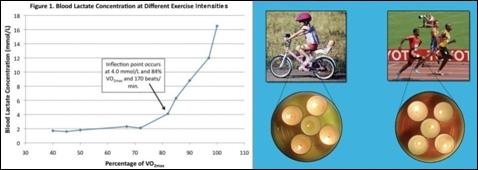
You have undoubtedly experienced the buildup of lactic acid when working hard and/or fast, which forced you to slow down and ‘catch your breath’. Let’s assume you already know oxygen exists, aerobic metabolism requires oxygen, and fat is a caloric fuel source. Knowing muscles produce the most intense bursts without oxygen/breathing, you are forced to conclude slower, less powerful, sustainable movements must involve a ‘nutritional reaction’ involving oxygen and fat. Since only carbohydrate can be used within the cytosol, this means the ‘oxygen-based nutritional reaction’ must happen elsewhere within the muscle cell. The candles must represent the anatomical space where aerobic metabolism occurs and the only place fat burns. There are no other choices to consider; you have been forced to these conclusions.
The words ‘anatomical space’ refers to an actual body part, similar to your nose or ear. Only two anatomical spaces exist for producing movement and metabolizing food, the cytosol and the ‘other space’. The other space is called the mitochondria.
To a professional stage magician, forcing is a technical term that means “the magician verbally forces the item which he wanted the spectator to choose.” This technique is also known as ‘magician’s choice’ – implying this writer could have chosen to examine both sections of the muscle responsible for producing power and movement, but I chose only one, namely the cytosol. Google ‘forcing magic trick’ or click Equivocation (magic).
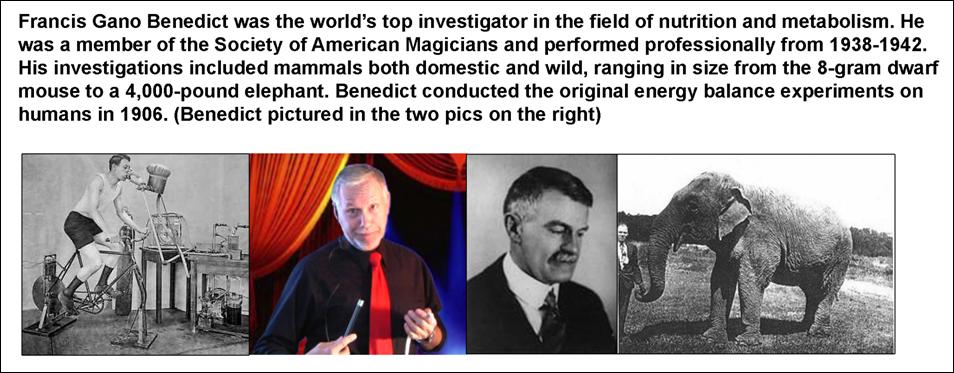
Read more on Benedict, The Magus of Metabolism:
http://www.sportsci.org/news/history/benedict/benedict.html
http://www.whonamedit.com/doctor.cfm/3319.html
The graphic below illustrates the two choices or ‘Two Ways to Produce Energy’ within cells. The blue text in the left column lists all aspects of ‘nutrition as an event’ during anaerobic exercise. I deliberately ignored events related to aerobic metabolism listed in the right column, and will continue to do so until we examine oxidative/aerobic metabolism. It may now appear obvious that most everything on the right could be deduced after learning the phenomena listed in the left column. Notice, ‘CARBS ONLY’ at the bottom of the left column indicates it is the only fuel used to produce anaerobic power. The ability to measure CARBS USED as energy enables us to calculate and eat a properly ‘balanced amount’ of carbohydrate.
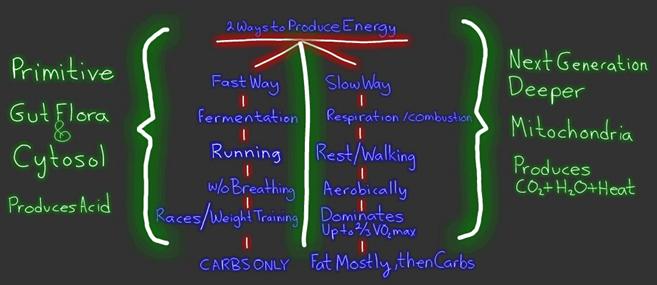
The only way to correctly ‘balance’ carbohydrate intake is relative to the quantity your body uses. The Carbohydrate Continuum quantifies carbohydrate requirements relative to exercise intensity, resting included. The gigantic wheel is an analog computer that calculates or shows how to match carb intake with respect to overall activity, goals, and training regimens. Rotating wheels such as this are technically called volvelles.
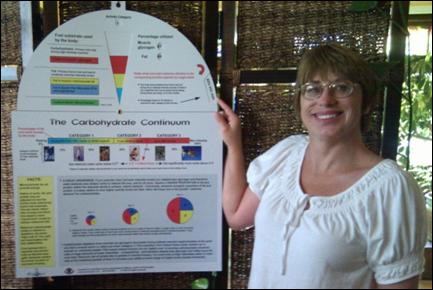
Consider this quote from Francis G. Benedict, from the preface of the 1906 book by Atwater & Benedict:
“The study of the transformations of matter is rendered more complete and intelligible by a knowledge of transformation of energy.”
It should be obvious that any nutrition program that does not match nutrient demand to the whole energetic picture is, by design, limited, stunted, or partial. Telling people to ‘eat a balanced variety of foods’ may not prevent disease or promote health because such recommendations do not account for how the body selectively uses nutrients – unless like a stopped clock, which tells correct time twice a day, a ‘lucky match’ occurs. The construction of the food pyramid and the Unified Guidelines of Nutrition resembles a stopped clock. Vague language and failure to quantify nutritional requirements specifically to the body’s physical demand exposes the problem of using a one size fits all approach to educate the public. (See “Creators of Guidelines of Nutrition” in the appendix of The Physical Rules.)
Politicians, policy makers, and lackey scientists consider a splatter ‘buckshot’ approach applicable for the masses, but this fails to satisfy an individual who desires to eat according to function, training goals, or specific healing modalities. The ‘limited nutritionist’ is satisfied with covering the bases and running a narrow path around the infield diamond, but the holistic thinker, trainer, or healer covers the whole field. He or she thinks in terms of systems and functional relationships.
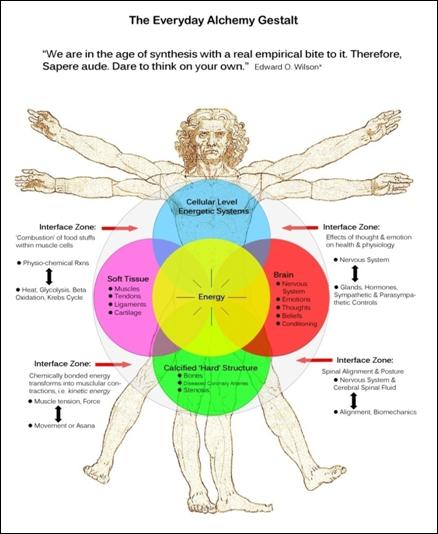
Summarily, eating nutrient dense foods according to guidelines increases the probability people may ‘cover the bases’ but this approach is still a crap shoot in terms of eating based on functional physiology or energetic demand. Following guidelines accompanied with the intent to prevent disease falls short of higher thinking, namely eating and training to promote health and regeneration. Trying to merely avoid disease is not the same as the expressed intent to promote health on a number of levels. This is akin to a golfer visualizing a tree and thinking, “Don’t hit the tree” just before teeing off. Working to avoid disease doesn’t mean you are doing what you need to do or eating what you need to eat to promote health and regeneration. You cannot know this unless you examine how your body uses nutrients in terms of energy and energetic relationships.
A wholistic, physics based ‘energetic model’ exposes wrong thinking expressed by ‘experts’ who have not been trained to think in terms of functional physical relationships. All this becomes clear through lessons on exercise physiology, which includes biomechanics, anatomy, and biochemistry.
Part II: The Art of Challenging Assumptions
Fortunately, a magician faces little to no resistance in ‘forcing a thought’ upon the audience, since most people possess no ‘magic knowledge’ and/or have nothing personally at stake regarding the outcome of someone applying the ‘science of magic’. The opposite is true when it comes to teaching the science of nutrition or applying exercise techniques. People hold deeply rooted beliefs, practice ingrained habits, and certainly do care about outcomes; resistance is common. So naturally, pointed questions tinged with disbelief often arise in peoples’ minds after their assumptions are challenged by factual statements such as, “fat is the primary fuel for the body at rest and during low to moderate exercise intensities”. Weight resists your movement, so why shouldn’t thoughts that challenge yours have a similar effect on your thoughts? Challenging assumptions is a hallmark of effective teaching.
Accordingly, I deliberately create phrases to challenge assumptions or ‘force’ concepts that may sound counterintuitive, but are irrefutable facts, such as:
“Cardiac output is identical in trained athletes and couch potatoes (untrained humans) at virtually all intensity levels.” Shown in frame 1, below left.
Frame 2: “Fat is the primary fuel for the body at rest and during low, moderate, and moderately high intensity levels.”
Frame 3: “Training does nothing to improve one’s ability to increase cardiac output or increase oxygen consumption.” (This applies to any given intensity level except maximum intensity, which is unsustainable.)
Frame 4: “Fat is the main fuel for the heart.” A strong and therefore healthy heart utilizes fat as its main fuel. As it begins to weaken and fail, carbohydrate replaces fat as the primary fuel. But progressively toward failure, each fuel is used less and less.

All the statements above are simply straight talk that people are not used to hearing. Dealing with perception is paramount. Providing a different perspective for people – as opposed to spoon feeding them with cliches that conform to expectation – stirs the thought pot and invites pointed questions. Posing a challenging question or statement ferrets out people’s beliefs, which helps both teachers and students clarify thoughts and identify where a ‘disconnect’ exists with respect to integrating parts within a whole. Schematics and visual props enable people to visualize connections among the parts of the whole. Understanding the connections between food and energy production is made possible by matching ‘activity’ of unseen metabolic events in muscle cells to the simultaneous movement of the whole body. But even this technique is limited; and this limitation points to the value of the next lesson.
